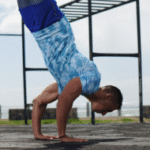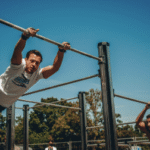Post-Injury Rehab: How Private Calisthenics Can Help You Recover
Recovering from an injury is more than just waiting for the pain to subside; it’s a journey of rebuilding strength, restoring function, and, most importantly, regaining confidence in your body. For many active individuals in Houston, the question of how to return to exercise safely is a major concern. Pushing too hard too soon can lead to re-injury, while being too cautious can lead to muscle atrophy and long-term weakness.
This is where private calisthenics training emerges as a powerful and intelligent tool for post-injury rehabilitation. Under the guidance of a skilled coach, using your own bodyweight as resistance offers a safe, controlled, and highly effective way to get back to full strength.
Important Note: This guide is for informational purposes. Always consult with your doctor or physical therapist before beginning any new exercise program after an injury. A great private coach will work in conjunction with your healthcare provider’s recommendations.
Why Calisthenics is Ideal for Rehabilitation
Calisthenics, or bodyweight training, has inherent advantages that make it perfectly suited for a safe recovery process.
Infinitely Scalable: This is the most significant benefit. Every single calisthenics exercise can be modified to match your current capacity. Can’t do a full push-up after a shoulder injury? A coach will start you with wall push-ups, then progress to incline push-ups, gradually increasing the load on the joint in a perfectly controlled manner. This principle of progressive overload is the key to safe strengthening.
Focus on Functional Movement: Calisthenics is built on fundamental human movement patterns—pushing, pulling, squatting, hinging. By retraining these core movements, you are rebuilding strength that translates directly to real-world activities, not just isolated gym exercises.
Improved Body Awareness (Proprioception): After an injury, the connection between your brain and the affected area can be weakened. Calisthenics forces you to be highly aware of your body’s alignment and muscle activation. A private coach will guide you to “feel” the right muscles working, re-establishing that crucial neuromuscular connection.
Low Impact on Joints: Since you are using your own body as resistance, there is less risk of the sudden, high-impact stress on your joints that can come from heavy weightlifting, making it a gentler way to reintroduce load to recovering tissues.
The Role of a Private Coach: Your Guide to a Safe Recovery
Attempting to rehabilitate on your own is risky. You can’t see your own compensatory patterns—the ways your body “cheats” to avoid using an injured area. A private coach is your safety net and your guide.
- The Comprehensive Assessment:
Your first session will be a thorough assessment. The coach will work with you to understand the nature of your injury, review recommendations from your physical therapist, and evaluate your current range of motion, stability, and strength. This creates a safe baseline to build from.
- Correcting Compensatory Patterns:
This is a coach’s most critical role in rehab. For example, after a shoulder injury, you might unconsciously hike your trap muscle to lift your arm. A coach will spot this immediately and provide cues and corrective exercises to ensure the proper muscles (like your deltoids and rotator cuff) are doing the work. This prevents you from building dysfunctional strength that could lead to future injuries.
- A Truly Personalized Program:
Your program will be designed around your recovery.
Targeted Strengthening: If you’re recovering from a knee injury, the program will focus on strengthening the supporting muscles like the glutes, hamstrings, and quads through safe, controlled exercises like glute bridges, bodyweight box squats, and assisted lunges.
Mobility and Flexibility Work: The coach will incorporate specific drills to restore a healthy range of motion to the affected joint without pushing it into painful positions.
Gradual Progression: The coach knows when to push and when to hold back. They will only progress you to a more challenging exercise variation when you have demonstrated complete mastery and control of the current step.
- Rebuilding Confidence:
An injury can create a fear of movement. The psychological barrier is often as significant as the physical one.
Creating Small Wins: By guiding you through achievable progressions, a coach helps you experience success in every session. The first pain-free push-up or squat after an injury is a massive confidence booster.
A Safe and Supportive Environment: A one-on-one setting allows you to move at your own pace, without pressure or judgment, and to communicate openly about what you’re feeling. This builds trust in the process and in your own body’s ability to heal.
Conclusion:
Recovering from an injury requires a smart, patient, and strategic approach. Private calisthenics training, under the guidance of an experienced coach, offers one of the safest and most effective pathways back to full strength. It allows you to progressively and intelligently reload your body, correct bad movement habits, and rebuild not just your physical capabilities, but also the confidence to move freely and powerfully once again. For anyone in Houston looking to make a strong and lasting recovery, it’s an investment in your long-term health and well-being.

Post-Injury Rehab: How Private Calisthenics Can Help You Recover
Route
Calisthenics Gym Houston Functional Bodyweight Training
Secondary phone: (346) 483-3195
Email: info@calisthenicsclubhouston.com
URL: https://calisthenicsclubhouston.com/
Monday 6:00 AM - 7:00 PM Tuesday 6:00 AM - 7:00 PM Wednesday 6:00 AM - 7:00 PM Thursday 6:00 AM - 7:00 PM Friday 12:00 PM - 6:30 PM Saturday 9:45 AM - 12:00 PM Sunday 3:00 PM - 5:00 PM





